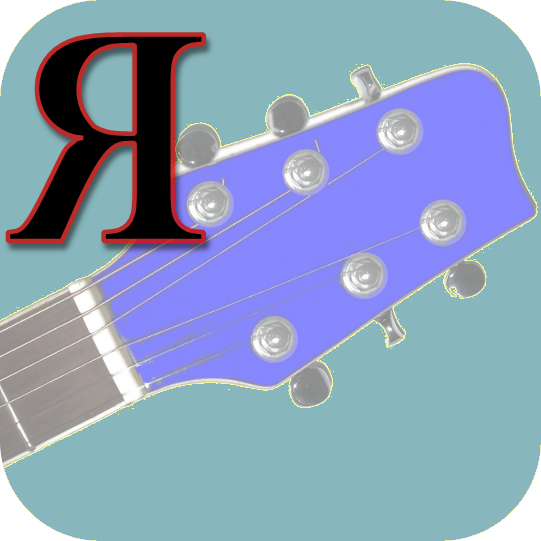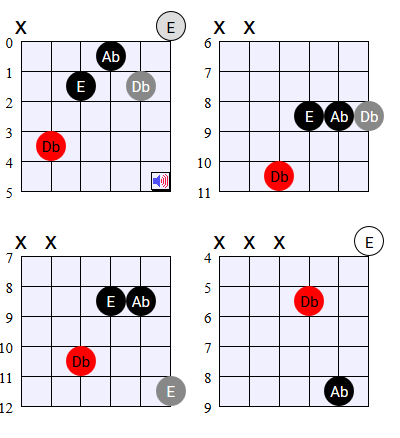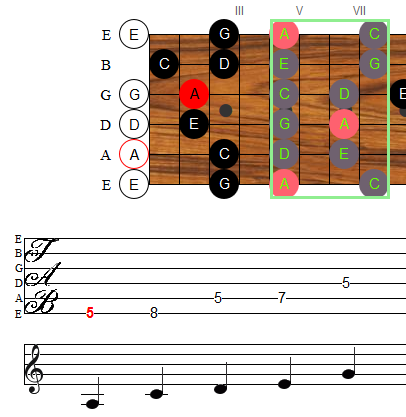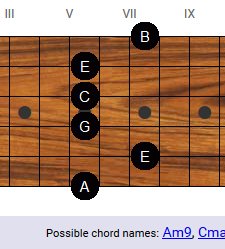The natural minor scale, which I covered in the last lesson, is a nice alternative to the major scale when you want a sadder, mellower kind of sound. It has a weaker resolution to the tonic, which can be just what you’re going for. Some people though, back in the day, decided they liked the sound of the minor scale, but wanted a little bit more of a strong resolution. They played around a bit, and what they came up with was the harmonic minor scale. That’s what I’m going to cover today.
Continue reading Harmonic Minor ScalesThe Guitarator Suite of Apps
The ultimate guitar reference tools for all platforms
 Guitarator Toolbox
Guitarator Toolbox
for Windows

- Includes Chorderator, Scalerator, and Reverse Chorderator
- Lefty mode
- Listen to chords and scales
- Share chord shapes
 Guitarator Toolbox 2.0
Guitarator Toolbox 2.0
for Mac OS X

- Includes Chorderator, Scalerator, and Reverse Chorderator, PLUS Metronome and Tuner
- Lefty mode
- Listen to chords and scales
- Share chord shapes
 Chorderator
Chorderator
for Android

- Look up chords for any tuning
- Listen to chords
- Share chord shapes
- Find related chords and scales
 Reverse Chorderator
Reverse Chorderator
for Android

- You design the chord, the app tells you what it’s called.
- Listen to the chord you designed.
- Integrates with Chorderator for Android
 Chorderator
Chorderator
for iPhone and iPad

- Look up chords for any tuning
- Listen to chords
- Share chord shapes
- Find related chords and scales
 Reverse Chorderator
Reverse Chorderator
for iPhone and iPad

- You design the chord, the app tells you what it's called.
- Listen to the chord you designed.
- Integrates with Chorderator for iPhone and iPad (iOS)
FREE Online Tools
Chorderator
Look up chords

Scalerator
Look up scales

Chord Designer
Reverse chord lookup

Natural minor scales
Minor scales
I covered major scales in the last lesson. Today I go minor. It’s really not that much of a leap from major to minor, so this should be an easy lesson, or at least easier. I’ll cover three types of minor scales in total: natural minor, melodic minor, and harmonic minor. Today, I’ll start with the easiest one, the natural minor.
Continue reading Natural minor scalesMajor scales and keys
I don’t know about you, but the word “scale” scares the crap out of me. I picture some white-wig-wearing little boy tinkling the same “do re mi” blah blah blah over and over on a piano as a stern-faced matron tells him to watch his posture.
Well, it’s not quite so bad as all that. Scales turn out to be enormously useful for coming up with melodies, soloing, and for practicing technique.
Continue reading Major scales and keysWhy Learn Music Theory?
So you’re a guitarist. You play by ear, you play what sounds good. You’ve never taken any theory lessons, and that hasn’t stopped you from writing kick-ass songs. Why should you care whether you’re playing in a minor key or a major key? Why should you care about intervals and note names and chord alterations and chord substitutions? Well, I’ll tell you why.
Continue reading Why Learn Music Theory?
Basic Chords
Categories: Music theory, Chords
Level: Beginner
From the previous lessons, you now hopefully understand how notes and intervals are named. Here I will cover the construction and naming of some simple chords. We already know that the space between two notes is called an interval. If we play the notes one after the other, it's called a melodic interval, because it's as if you're playing a melody. If we play them at the same time, it's called a harmonic interval, because it's, you know, a harmony. Now if we take a harmonic interval, and add a third different note, we have a chord. That was easy, right? After that, we can keep adding more notes to make more and more complicated chords, but for this lesson let's stick with three-note chords, also called triads, for all you Latin-speakers. By the way, does anybody else remember the old game Rise of the Triad? Back in I think '95 or '96, I think it was. Somewhere between Doom and Duke Nukem 3-D, it was my favorite game. Anyway, that's irrelevant. Where were we? Oh yeah, so basically, the definition of a chord is just any three different notes played at the same time. The intervals between these three notes define what the chord sounds like. There are a lot of different possible combinations of intervals, but only a few that are commonly used. Continue reading Basic Chords